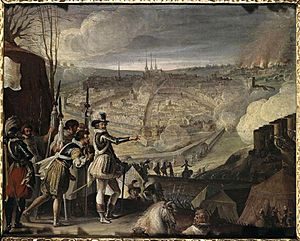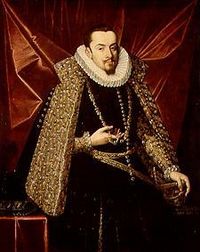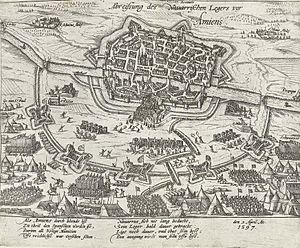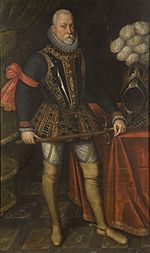Siege of Amiens (1597) facts for kids
Quick facts for kids Siege of Amiens |
|||||||
|---|---|---|---|---|---|---|---|
| Part of the Franco-Spanish War (1595–1598) & Anglo-Spanish War (1585–1604) | |||||||
 Henry IV before Amiens Anonymous, Versailles Museum |
|||||||
|
|||||||
| Belligerents | |||||||
| Commanders and leaders | |||||||
| Strength | |||||||
|
12,000 infantry
|
29,000 infantry
|
||||||
| Casualties and losses | |||||||
| 600 killed or wounded | 2,000 killed or wounded, 5,000 surrendered |
||||||
The Siege of Amiens was a big battle that happened between May 13 and September 25, 1597. It was part of the Franco-Spanish War (1595–1598) and the Anglo-Spanish War (1585–1604). The Spanish army had cleverly captured the city of Amiens. But Henry IV of France, the French king, quickly gathered a large army, including soldiers from England. They surrounded Amiens to take it back.
A Spanish army tried to help the city, but they couldn't break through the French and English forces. In the end, Amiens was returned to King Henry IV. This victory helped Henry make peace with Spain and also led to the Edict of Nantes, which brought an end to the French Wars of Religion. The siege was one of the last major events in these wars.
Contents
Background to the Conflict
Spain, led by King Philip II, often got involved in France's French Wars of Religion. Spain supported the Catholic League against the Huguenots (French Protestants). This happened in battles like the siege of Paris (1590).
In 1595, Henry IV, the new French king, officially declared war on Spain. Henry had become Catholic and was welcomed in Paris. After this, the civil war in France started to turn against the Catholic League, who were supported by Spain. France won important battles at Fontaine-Française and Ham in 1595.
However, Spain fought back strongly the next year. They captured several French towns like Calais.
Spain's Clever Plan to Take Amiens
In 1597, Hernando Tello Porto Carrero, a Spanish governor, suggested a plan to Archduke Albert. He wanted to capture Amiens, the main city of Picardy, by surprise. The Archduke agreed, hoping this win would make up for a recent loss to Anglo-Dutch forces at Turnhout.
Porto Carrero was given 7,000 foot soldiers and 700 horsemen. His plan was to hide 500 soldiers near Amiens. Then, sixteen Spanish soldiers dressed as farmers entered the city.
On March 11, these "farmers" went through the Montrescu Gate. One group "accidentally" dropped sacks of walnuts and apples. When the French guards bent down to pick them up, the "farmers" pulled out pistols. They quickly took over the guards. One guard tried to close the city gate, but a wagon full of wood, placed by the "farmers," stopped it.
Just then, the 500 hidden Spanish soldiers rushed into the city. Amiens was quickly under Spanish control with almost no fight. Even today, people from Amiens are sometimes called walnut eaters because of this clever trick.
King Henry IV's Response
King Henry IV was in Paris when he heard the news. He immediately got ready for battle. The situation was serious because Amiens' capture opened a path for Spain to attack Paris.
At this time, France and Spain were discussing peace. Taking back Amiens would give Henry a strong position in these talks. It meant the Siege of Amiens would decide the war.
However, Henry's government didn't have much money for war. Also, some of his old Protestant allies were unhappy that he had become Catholic. They didn't want to join the fight unless they got special rights. Henry needed help, especially money and soldiers from England. Queen Elizabeth I of England eventually agreed to send her troops.
The Siege Begins
On May 13, King Henry quickly brought an army of 4,000 French and Swiss foot soldiers and 700 French horsemen to Amiens. He promised important rights to the Protestants, and he kept this promise after the siege. More soldiers from all over France joined this army. A big help came from England, as Queen Elizabeth sent 2,000 English troops led by Sir Thomas Baskerville. Another 1,500 English soldiers joined from Rouen. Many of these English soldiers were experienced fighters from battles in Flanders.
This large army cut off the supply routes to Amiens. The Spanish inside the city were surprised by how fast the French reacted. Many civilians were sent out of the city, and Amiens got ready for a long siege. The French army camp grew, and they had plenty of supplies. Two hospitals were set up, and the Duke of Sully paid for the army.
The French army dug long, parallel trenches, which was a new tactic in siege warfare at the time. The Spanish tried many times to attack these trenches, but they mostly failed.
On May 22, 1597, Porto Carrero, the Spanish commander, led 500 horsemen in a fierce attack on the French headquarters. They captured a small fort. After two hours of fighting, the French drove the Spanish out. The French almost got into the city, but 400 Spanish foot soldiers arrived and pushed them back.
In mid-June, Queen Elizabeth sent more English soldiers, 700 troops led by Sir Arthur Savage. With these new soldiers, the English force grew to almost 4,200 men. Sir Arthur Savage later took over as commander of the English forces in France because Sir Thomas Baskerville became ill.
On September 4, French soldiers captured a part of the city's defenses on the south side. During this attack, Porto Carrero was killed. Girolamo Caraffa took his place as the Spanish commander. Four days later, a French artillery leader, François d'Espinay de Saint-Luc, was killed. King Henry was very sad about this loss.
Inside Amiens, the situation was very bad. Many Spanish soldiers were sick, and they didn't have enough food. Caraffa sent messengers to Archduke Albert, asking for help. Two of them managed to get through.
Spain's Attempt to Relieve Amiens
On September 10, Caraffa learned that two Spanish armies were coming to help. One was led by Archduke Albert, and the other by Peter Ernst I von Mansfeld-Vorderort. Together, they had over 25,000 soldiers.
Charles, Duke of Mayenne, a French commander, convinced King Henry IV not to fight this huge Spanish army in an open battle. He knew the French were outnumbered. Instead, they stayed in their strong trenches. This plan worked.
Von Mansfeld's army arrived near Amiens on September 18. On September 20, he launched an attack on the French and English camps. But all his attacks were pushed back, and the Spanish suffered heavy losses. During one attack, Arthur Chichester, 1st Baron Chichester, an English commander, was wounded. King Henry honored him for his bravery.
Archduke Albert arrived the next day with all the troops he could gather. He hoped to break the siege. He ordered his cannons to fire to let the trapped soldiers in Amiens know help was near. Albert tried to build a bridge over the Somme river, but bad weather and rising water stopped him. He eventually reached the southern bank, but French cannons forced his soldiers back.
The Spanish planned another attack for the next day. But when Archduke Albert saw how strong the French and English trenches were, he decided not to risk more heavy losses. Even though the Spanish relief army had more soldiers, their spirits were low. After being pushed back many times and with rumors of soldiers refusing to fight, the Archduke decided the situation was hopeless. He called off the attack and ordered his army to retreat.
King Henry's army followed the Spanish, bothering them as they left. But the Archduke avoided a big battle and quickly retreated under the cover of darkness. The King then focused back on the city of Amiens.
The Surrender of Amiens
King Henry could see that the Spanish inside Amiens had no hope. Soon after the Archduke's retreat, he asked Caraffa to surrender. Caraffa sadly agreed. Talks for the city's surrender began and were signed on September 25.
Henry allowed the Spanish soldiers to surrender with honor. He watched as the Spanish forces marched out of the city.
After the Siege
The Spanish paid a high price for the siege. Over 5,000 soldiers were captured in Amiens, many of them wounded or sick. The Spanish relief army also lost nearly 2,000 soldiers, many to disease. As the surrendered Spanish troops marched past, they pulled hundreds of carts filled with dead and wounded soldiers.
With the help of two field hospitals, King Henry's forces had only moderate losses, about 600 soldiers. Because of these low losses, the Siege of Amiens became known as the velvet siege. This was one of the first battles where field hospitals were used.
The siege also had important effects on the war. Because Archduke Albert focused on Amiens, the Spanish forces guarding the border with the Dutch Republic were left alone. This allowed Maurice of Orange to capture several cities in his successful campaign of 1597.
With Amiens back in French hands, King Henry was in a good position to make peace. He also needed to bring the rest of France under his control. The next year, Henry launched a campaign in Brittany, where the last of the Catholic League still held out. This campaign was a great success. Henry kept his promise to give important rights to Protestants, a promise he made during the Amiens siege.
Finally, the Duke of Mercœur, the last League leader, gave up on March 20, 1598. Henry then marched into Nantes and issued the Edict of Nantes on April 13, 1598. This important document officially ended the French Wars of Religion.
Peace of Vervins Treaty
The victory at Amiens was celebrated as a huge success. It was a turning point towards peace between France and Spain. Spain was struggling financially and had too many problems. They had lost money from the capture of Cadiz, and two expensive attempts to invade England had failed. Their war against the Dutch was also not going well. Soldiers in Spanish-held towns were also refusing to fight.
Because of these problems, King Henry made sure the Peace of Vervins treaty was signed. This treaty ended the war between Spain and France. It was very good for France. Philip II, who was old and sick, recognized Henry as the true King of France. Also, Spanish-ruled towns were given back to the French king. The Peace of Vervins was a final defeat for Philip II. It showed the beginning of the decline of Habsburg Spain and the rise of France as a major power in Europe.
Notable Participants
- Thomas Dudley, an English leader who later became governor of the Massachusetts Bay Colony in America.




